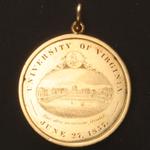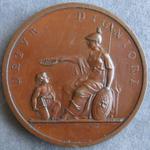
PREV ARTICLE
NEXT ARTICLE
FULL ISSUE
PREV FULL ISSUE
MORE ON NUMISMATIC TRANSLATIONS Last week, Dick Johnson submitted a question about numismatic legend translations. One specific example was a medal with the inscription: OPUS AG II -Editor Dick Johnson writes: I received a most interesting comment from good friend John Sallay in response to my item in last week's E-Sylum on translating difficult coin and medal legends. John made several recommendations. John Sallay writes: The item in The E-Sylum regarding translation of Latin inscriptions on coins and medals really hit home with me, since I often find myself trying to translate the Latin (and sometimes ancient Greek) inscriptions that I find on school award medals. Even when not awarded for excellence in studying Latin, these medals often had Latin inscriptions because that was the language of educated men. I didn’t study Latin, but my wife is a Latin teacher and she has helped me along to the point where I can sometimes figure out these inscriptions almost as well as she can. That’s not to say that I know the language, but rather that these inscriptions are almost like a sub-language and there are certain phrases and abbreviations that keep coming up. As background, Latin words were not separated by spaces the way we separate words in English today. (The Irish were the first ones to do that). Often though, the Romans separated words and abbreviations with dots inserted between the words, and this helps. Also, the order of the words enhances the readability and sometimes affects nuances of meaning, but doesn’t change the meaning of a sentence written in Latin. There are several common abbreviations, similar to the D.G. (meaning Dei Gratia, or By the Grace of God) on British coins that everyone just knew. For example, IMP stood for “Imperator” or emperor, M stood for Marcus and so forth. The point of the abbreviations was not so much that there was limited room on a coin, because they also did all of this abbreviating on gigantic monuments as well. It was a waste of space to spell out something that everyone knew, similar to the way we usually use USA instead of spelling it all out. As a result, the online Latin translators are essentially completely useless for this purpose. However, there is a group of Latin teachers who run a blog called LatinTeach and if you got involved in that, you might get more help than you bargained for: Latinteach mailing list Latinteach@nxport.com http://nxport.com/mailman/listinfo/latinteach Having said that, I find that if I type a complete Latin phrase on a medal into Google, it sometimes comes back with clues that the inscription is part of a famous quotation from Virgil or Horace or another famous writer. These references are particularly interesting because – just as the words are often abbreviated – the quotations are often abbreviated, too. Knowing the full quotation illuminates the true underlying motivation for using that particular quotation on the award medal. Without going into more detail, take a look at a couple of medals from my collection on NeoCollect, both with obscure but very funny and ironic underlying meanings which are explained the descriptive text:  University of Virginia, Jefferson Society http://www.neocollect.com/item/34/ University of Virginia, Jefferson Society http://www.neocollect.com/item/34/  Blundell’s School, Keats Medal http://www.neocollect.com/item/1474/ Blundell’s School, Keats Medal http://www.neocollect.com/item/1474/ Dick Johnson adds: I would like to extend my enthusiastic endorsement of John Sallay's new collector web site, Neocollect, noted in the two above citations. It was announced recently here in The E-Sylum (Vol 12, No 8, Art 4; February 22, 2009). John offers a unique and very useful service to collectors at this site. You can catalog and illustrated your collection on his website as a service to other collectors. This is particularly useful for such non-uniform items as medals. They can be identified as to recipients' names or other inscribed lettering. John's specialized topic of School Medals is an excellent example (and perhaps was the inspiration for the web site's creation). With inscribed recipient's name each medal is unique for that year. This information is quite useful for other collectors who have similar items in their collections. The two medals John cites are examples where the Latin inscriptions add tremendous interest and collector lore to the individual piece. Check out John's web site. You may want to use his free web site for your own collection. Renee Shomaker writes: Regarding the query on "Numismatic Translation, Interpretation and Estimation" in the latest Esylum newsletter, in particular the last paragraph: Does anyone reading this, perhaps with a 3,000 IQ who knows many languages, would like to start a web site that would record coin and medal inscriptions and who can provide their meaning in plain text English? You would earn the everlasting approbation of those of us who toil in the numismatic field and feel stumped by the mystical lettering. We could feed you a lot of these for your translation, interpretation and estimation. I am currently in development of a numismatic web site that I would be more than happy to integrate this information into (or build a separate site for) and help research the unknown inscriptions. A collaborative effort here would be wonderful - I know of many others who would also be willing to contribute their knowledge. Something like this would be an invaluable resource for all, and I would be glad to assist in the effort! You can reach me at admin@numishub.com John Lupia writes: The inscription OPUS AG II is difficult to interpret out of context not having seen the medal. If it is Latin with the abbreviation AG II it might refer to the work (OPUS) of a person whose initials are A. G. and II could mean the second, or Junior. It could mean Ad Gentes "To the Peoples" the Vatican II motto for the missionary activity of the Church "The Work To the Peoples (of the world)", hence II signifying Vatican II. It could simply be a corporate name OPUS AG LLC, in Purchase, New York, where AG means Advisory Group. I hope you appreciate the difficulty and complexity of the problem when inscriptions are taken out of context. Tom DeLorey writes: Is the piece made of silver? That might explain the AG. Perhaps a second place silver medal? Any chance of getting a picture? John Isles writes: If one who knows Latin may try to answer Dick Johnson’s query in the latest E-Sylum, a definite answer can’t be given because OPUS AG II is not a Latin phrase. ‘Opus’ does indeed mean ‘work’ in Latin (but not ‘deeds’; it’s singular). AG must be an abbreviation, if not some initials then perhaps representing the chemical symbol for silver, Ag. Was the medal in silver? II must be the number 2 in Roman numerals. Were there perhaps two medals individually numbered? Or is this ‘silver, opus No. 2’? Wayne Homren, Editor The Numismatic Bibliomania Society is a non-profit organization promoting numismatic literature. See our web site at coinbooks.org. To submit items for publication in The E-Sylum, write to the Editor at this address: whomren@gmail.com To subscribe go to: https://my.binhost.com/lists/listinfo/esylum All Rights Reserved. NBS Home Page Contact the NBS webmaster 
|